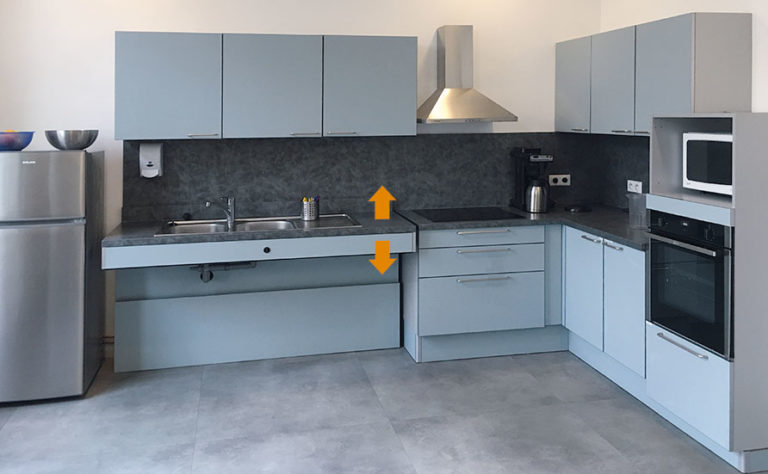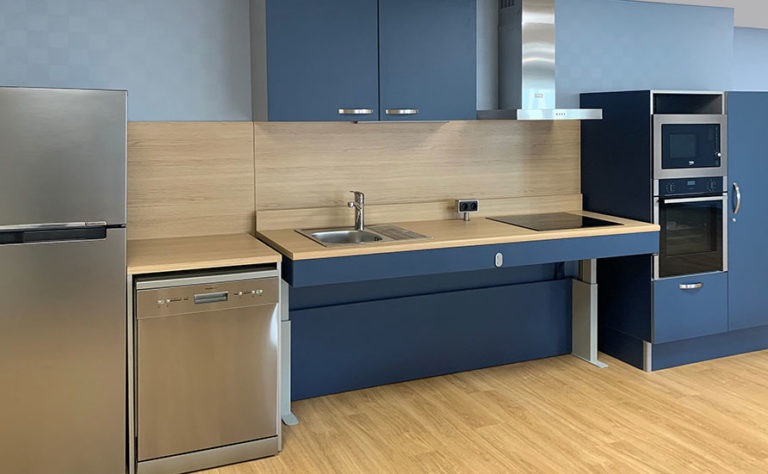Would you like to contact us for help?
Because they have special needs, some disabled children require an adapted bed. This type of bed is safer and more secure for the child, and also makes everyday life easier for parents and carers. To help you choose the perfect bed, here are a few questions to ask yourself.
What do you need a therapeutic kitchen for? For group activities, rehabilitation or patient observation sessions, or for intensive use?
Is it better to opt for a linear, corner or island kitchen? How many height-adjustable units are needed? Who will be using the kitchen? How often? What budget is available?
Would you like to separate the sink unit and hob on two different worktops?
Do you need any household appliances? A fridge and/or freezer, and what size? An oven at an easy height for wheelchair access and standing, with a door that slides under the oven for easy access? A floor-mounted or overhead dishwasher? A 2-, 3- or 4-ring hob? A cooker hood? A microwave?
Also take into account the number of sockets needed for small appliances (coffee machine, food processor, kettle, mixer, etc.) and, if you wish, opt for adjustable worktop sockets that follow the rise and fall of the worktop.
Do you need storage columns? Locks on the doors?
Finally, you can choose a central table that is height-adjustable and easy to move, to make group work easier.
All these questions (and many more) will help you to define your project, so you can be sure that your therapeutic kitchen will be perfectly functional once installed.
Ergosolutions kitchens are made-to-measure to suit all projects, whatever the layout, and have the advantage of not requiring load-bearing walls.
An ergonomic or therapeutic kitchen is very different from kitchens for the general public. It must be designed - often with the help of an occupational therapist - and installed by professionals. Ergosolutions has an experienced team and also provides an efficient and responsive after-sales service. By choosing Ergosolutions, you can be sure that your project will be a success, with no stress and no surprises.
Particularly well-suited to therapeutic kitchens, height-adjustable worktops and elements are central to the project. They can be adapted to suit each user (wheelchair users, able-bodied people, people of different heights, etc.).
and to be able to access furniture easily and independently.
Ergosolutions kitchen worktops and wall units are adjustable by crank or electric control and have a built-in safety device.
Your therapeutic kitchen is destined to become a place where patients, carers and occupational therapists will enjoy meeting up. It should be with you for many years to come! At Ergosolutions, we put quality first. Our furniture and mechanisms are particularly robust, and the quality of our design and installation is regularly praised by our customers. All our kitchens are made in France. Proof of their quality over time: they are easy to assemble and dismantle.
Your therapeutic kitchen is destined to become a place where patients, carers and occupational therapists will enjoy meeting up. It should be with you for many years to come! At Ergosolutions, we put quality first. Our furniture and mechanisms are particularly robust, and the quality of our design and installation is regularly praised by our customers. All our kitchens are made in France. Proof of their quality over time: they are easy to assemble and dismantle.




For a turnkey therapeutic kitchen tailored to your needs and budget, contact Ergosolutions on 01 84 600 610 or send an e-mail to contact@ergosolutions.fr.